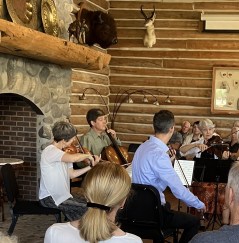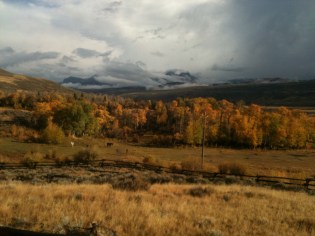Dear friends and readers,
Thank you, one last time, for joining me here. The time has come for a farewell.
I’d like to explain.
I sometimes say that this blog is about a city girl moving to the wilderness. Only half of that is true.
For most of my life I was a city girl, but since coming here I never actually lived in the wilderness.
I look at that wilderness every morning, and dream about going back in there again. I’ve hiked up there and ridden in on horseback. I’ve camped in a valley beneath those magnificent buttes, and gone in as far as possible behind those crags on an all-terrain vehicle.
But actually I live in a comfortable house with all of the modern conveniences, less than 500 feet from the highway that leads to Yellowstone. The drive into town takes 15 minutes. Day to day, except for my hikes, my life is just about like anyone else’s.
Like countless others, I came west for an adventure and to reinvent myself. I was lured by the endless space, the soul-restoring mountain and desert landscape, and a fascination with the legacy of those who came here long ago.
Everything I saw was fresh, remarkable, and full of wonder, and I have tried to share that.
Indeed, I did reinvent myself. I never did a moment’s work on a ranch, never even split a log, but I am certainly no longer a city girl. My perspective and my predilections have changed. Also the way I dress.
Along the way, I gradually became attuned to some common misconceptions about the nature of this part of the country. For instance, the romance of the cowboy mystique doesn’t accurately convey the brutality and struggles of that life. These days, a cattle ranch is often a hobby for the super-rich and seldom a viable economic enterprise.
The legendary “rugged independence” of spirit in the West often goes hand in hand with near-suicidal loneliness and desperation. And yet the irony is that many people in this situation would have it no other way.
A hundred and fifty years ago, this type of area attracted many for the opportunity to work incredibly hard and build something of lasting value. Many did (and many others did not, and either left or died trying). Today, it is a challenge to relocate here and find decent housing and a life-sustaining permanent job. I was fortunate to have one already, and to be able to work remotely, but many long-time time locals struggle mightily to stay afloat financially in an economy dominated by seasonal tourism.
I know that over the past 8 years this blog has been read by others who were curious about moving to this remote little valley. In fact, that was its original intent, back 8 years ago when Dubois seemed like the best-kept secret in the West.
Eventually I began to wonder whether that was a good thing to do, whether big-city sensibilities might slowly erode what Dubois residents had come to cherish. This is one reason I have posted less and less. I began to face the prospect of writing any new post with apprehension.
Then, while I was preparing to post this farewell, I received a comment to my original post from a man whose small Colorado farming community has suffered exactly what Dubois hopes to avoid. It is a cautionary tale worth reading. (Scroll down to read the words by Rick.)
For those who want to read other people’s reflections about the American West, there are many great writers, among them Wallace Stegner (the best of all), Willa Cather, Kent Haruf, Cormac McCarthy, Annie Proulx (mentioned with reservations; many people feel she does not portray Wyoming fairly), and Mark Spragg. Wyoming Public Media posts a great podcast called The Modern West.
Or you may want to enjoy the songs on the album “Wyoming” by another skillful storyteller (and a fellow migrant to Dubois), singer-songwriter Skip Ewing. In the title track, his character says, “I didn’t stop to think out problems, I just headed west. I thought I’d get where I was going, but I haven’t yet.” It’s so true, for so many.
Fundamentally, and fittingly, living in Dubois is no longer an adventure for me, because it has become the familiar, and therefore I can’t write as if it is still an adventure. I have always known that there are other equally satisfying places to live. But as Skip Ewing sings, “my heart’s inclined to stay” in Dubois.
Fundamentally, I am very glad that I took my “leap” West, and would never want to live anywhere else. If you are still deciding about yours, I wish you an adventure of your own, and a journey that leads you home.
Thanks for sharing mine.
© Lois Wingerson, 2023























 The autumn solstice passes. The days of daylight savings time are numbered.
The autumn solstice passes. The days of daylight savings time are numbered. The wise and knowing hands of Helping Hands Massage Therapy are exploring and unwinding the knots and kinks in my muscle tissue. I have been to some of the best musculoskeletal specialists at the best hospitals in New York City, but Reenie’s exquisite skill has done more for my particular woes than all of them combined, and she is doing it now. What a blessing for me that she found her way here, before I even came.
The wise and knowing hands of Helping Hands Massage Therapy are exploring and unwinding the knots and kinks in my muscle tissue. I have been to some of the best musculoskeletal specialists at the best hospitals in New York City, but Reenie’s exquisite skill has done more for my particular woes than all of them combined, and she is doing it now. What a blessing for me that she found her way here, before I even came. Somewhere there’s also the sound of trickling water, which brings me back to one reason why I’m here now: The mingled joy and stress of my last serious hike. A friend and I took the day off and clambered up to Lake Louise, a hidden glacial lake which is the splendid reward after more than an hour of trekking, much of it straight uphill on rocky ground.
Somewhere there’s also the sound of trickling water, which brings me back to one reason why I’m here now: The mingled joy and stress of my last serious hike. A friend and I took the day off and clambered up to Lake Louise, a hidden glacial lake which is the splendid reward after more than an hour of trekking, much of it straight uphill on rocky ground. Here’s one reason I need a massage today: The hike to Lake Louise ends in a rising field of solid granite, where the trail vanishes . You’re left on your own to clamber up any way you can, on hands and feet if all else fails. At the top, it’s so windy I fear I might be pitched over the edge. My friend remembers that, years ago, they brought fishing rods but could not fish. It was too windy.
Here’s one reason I need a massage today: The hike to Lake Louise ends in a rising field of solid granite, where the trail vanishes . You’re left on your own to clamber up any way you can, on hands and feet if all else fails. At the top, it’s so windy I fear I might be pitched over the edge. My friend remembers that, years ago, they brought fishing rods but could not fish. It was too windy.













 As spring brings life to the valley, an enchanting new creation is unfolding beside the highway, just east of the rodeo grounds. What makes the place seem even more magical is that it used to be a toxic waste site.
As spring brings life to the valley, an enchanting new creation is unfolding beside the highway, just east of the rodeo grounds. What makes the place seem even more magical is that it used to be a toxic waste site. Ten years after the mill closed, a local family bought the site and donated it to the Nature Conservancy, stipulating that it should be used for the “health and enjoyment of the citizens of the greater Dubois community and its future generations.” After the town gained numerous grants, the
Ten years after the mill closed, a local family bought the site and donated it to the Nature Conservancy, stipulating that it should be used for the “health and enjoyment of the citizens of the greater Dubois community and its future generations.” After the town gained numerous grants, the  The good folks of
The good folks of  DAWGS long ago made the river accessible for handicapped anglers along this riverwalk. Now, on the landward side of the walk, they’re busy with backhoes creating not just a pond, but a whole new park. There’s a small stream at the inlet, and islands in the center of the pond.
DAWGS long ago made the river accessible for handicapped anglers along this riverwalk. Now, on the landward side of the walk, they’re busy with backhoes creating not just a pond, but a whole new park. There’s a small stream at the inlet, and islands in the center of the pond. It’s a pleasure to think that this is what future travelers will see first as they pass into Dubois headed toward Yellowstone and Jackson. After that long desert drive from Rawlins or Casper, they will be enticed as they reach Dubois to stop and enjoy birds and gently lapping water, lined by trees and bordering the river.
It’s a pleasure to think that this is what future travelers will see first as they pass into Dubois headed toward Yellowstone and Jackson. After that long desert drive from Rawlins or Casper, they will be enticed as they reach Dubois to stop and enjoy birds and gently lapping water, lined by trees and bordering the river.